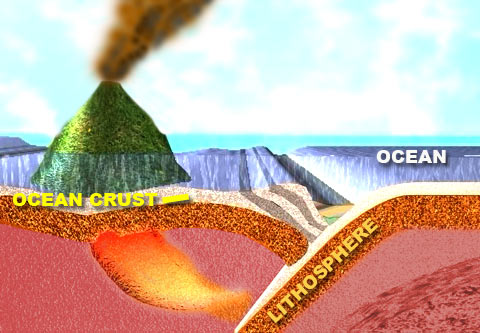Convergent margins include subduction zones. Since one plate is going beneath another much of what happens can only be inferred from observation of secondary occurrences.
Magmatic Arcs:
As the lithosphere descends it carries with it some wet oceanic crust. The hydrous minerals give up the water and start wet partial melting. The resultant magma is an andesite. As it begins its rise back to the surface it produces an arc shaped region of magmatic activity and if under ocean crust it will produce a volcanic island arc. If it is under a continent it can produce a continental volcanic arc.
The resultant volcanoes will appear between 100 and 400 km (60-250 miles) behind the trench formed from the subduction. The distance is based on the angle of plunge.
Older crust that has reached thermo-equilibrium is heavier and thus plunges faster than younger (hot) crust. The faster plunge makes it more steep and gives it a wider arc. Warmer crust plunges at a lower angle and a short radii of curvature.
Earthquakes can continue for as long as down sloping lithosphere maintains some degree of brittleness. That appears to stop at about 700 km (430 miles) of depth. At this depth the descending lithosphere reaches the same temperature as the surrounding asthenosphere.

This is a chaotic mixture of faulting, thrust faulting, and bending of rock that happens at the edge of some margins. once the subduction zone forms, and the resultant trench begins to fill with sedimentary rock.
The descending plate carries some of this rock down. As it is low density material it cannot travel down very far. It gets pressed between the two pieces of lithosphere and becomes crushed and totally shattered. This creates a metamorphic rock which had high pressure and low temperature. (pro grade metamorphic in regional metamorphism) (blueschist)
The fore-arc ridge is a slight buckling of the crust and lithosphere on the stationary side of the convergent margin. It is caused by thrust faulting at the edge of the top plate.
If the subducting plate is moving fairly fast, and the top plate is not, then the top of the upper plate may be subjected to tension (pulling sharply downward with stretching of the top.) This stretching may decrease the thickness of the plate behind the magma uplift. This called a Back-arc basin.
Without an external frame of reference we cannot get absolute velocity. When one plate moves by another we can measure the rate of movement, but cannot necessarily say which plate is moving or how fast. What we can say is that the two plates are moving by one another at 8 cm per year. Unless we can get off of the two plates and look at them relative to a third we can only give their relative velocity with regard to each other.
A century ago Jame Dana observed that the volcanoes in the Hawaiian island chain get older as you move Northeast. A Canadian scientist, J.T. Wilson suggested that this might make an interesting proof of the sea floor spreading theory.
If you assume that there is a single hot spot in the Pacific Ocean and that the sea floor is moving over it, then one might expect a chain of volcanoes, each growing for a time until it moved further Northwest. If you measure the time differential from the most Northeastern island to the current island of Hawaii, you can calculate that each volcano must have spent about 1 million years over the hot spot.
What is even more interesting is that there are many more sea mounts that appear to have been a part of the island chain long ago, but are now just sea mounts on he ocean floor. When they are all taken together the story is a little different than one might expect.

The chain runs in a straight line for about 40 million years. Then it abruptly changes direction! About 40 million years ago the Pacific Plate was moving in more northern direction, and then it shifted almost 45° to a Northeasterly direction.
More hot spots have since been identified and have provide information about many of the plates.
Pacific Plate and Hot Spot
Hawaii today (Figure 1)
Winding the clock back 40 million years (figure 3), then back to 60 million years ago (figure 4).
At 40 million years ago (figure 3) there was a pronounced shift in plate direction.
| NEXT | TOC | PREV |